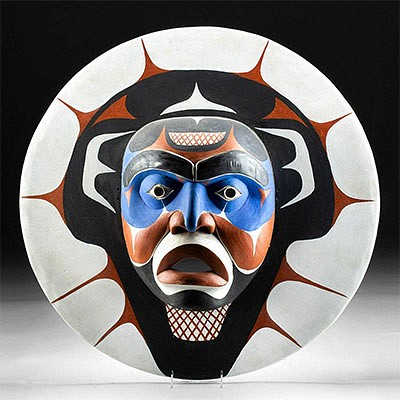Cocle Polychrome Olla + Fruitera, Museum Exhibited
Lot 29j
About Seller
Artemis Gallery
686 S Taylor Ave, Ste 106
Louisville, CO 80027
United States
Selling antiquities, ancient and ethnographic art online since 1993, Artemis Gallery specializes in Classical Antiquities (Egyptian, Greek, Roman, Near Eastern), Asian, Pre-Columbian, African / Tribal / Oceanographic art. Our extensive inventory includes pottery, stone, metal, wood, glass and textil...Read more
Categories
Estimate:
$1,800 - $2,500
Absentee vs Live bid
Two ways to bid:
- Leave a max absentee bid and the platform will bid on your behalf up to your maximum bid during the live auction.
- Bid live during the auction and your bids will be submitted real-time to the auctioneer.
Bid Increments
| Price | Bid Increment |
|---|---|
| $0 | $25 |
| $300 | $50 |
| $1,000 | $100 |
| $2,000 | $250 |
| $5,000 | $500 |
| $10,000 | $1,000 |
| $20,000 | $2,500 |
| $50,000 | $5,000 |
| $100,000 | $10,000 |
| $200,000 | $20,000 |
About Auction
By Artemis Gallery
Mar 18, 2021
Set Reminder
2021-03-18 10:00:00
2021-03-18 10:00:00
America/New_York
Bidsquare
Bidsquare : Pre-Columbian | Tribal | Oceanic
https://www.bidsquare.com/auctions/artemis-gallery/pre-columbian-tribal-oceanic-6520
Featuring Pre-Columbian, Native American, African / Tribal, Oceanic, much more. All items have been legally acquired and are legal to sell. Convenient in-house shipping. Artemis Gallery info@artemisgallery.com
Featuring Pre-Columbian, Native American, African / Tribal, Oceanic, much more. All items have been legally acquired and are legal to sell. Convenient in-house shipping. Artemis Gallery info@artemisgallery.com
- Lot Description
Pre-Columbian, Central America, Panama, Gran Cocle, ca. 800 to 1200 CE. A wonderful pair of Cocle ceramics, including an ample olla and a large pedestaled fruitera, both extensively decorated in a polychrome palette of red, plum, beige, and black pigments. The large bowl of the fruitera is adorned with an overall geometric pattern that is impressively intricate, and the pedestal is decorated with interlocking diamond and v-shaped motifs. The voluminous olla presents a round-bottomed body with curving walls, and a short neck that rises to a gently flaring rim. The exterior walls are decorated with elaborate curvilinear and barbed motifs housing two abstract visages of mythical beasts in black, red, and purple pigments atop the cream-hued ground. The mythical animals shown here would have been of shamanic or spiritual importance, and the use of the purple pigment suggests this vessel is of the Conte/Macaracas artistic style. Two lovely vessels from the ancients of Panama! Fruitera: 10.75" W x 8.375" H (27.3 cm x 21.3 cm) Olla: 6.75" W x 5.625" H (17.1 cm x 14.3 cm)
Beyond the figural iconography, geometric design elements on Cocle pottery were imbued with powerful symbolism, usually referring to the gender constructs. For additional information on iconography, see Armand J. Labbe's "Guardians of the Life Stream" (Bowers Museum of Art, 1995).
According to scholar Samuel Kirkland Lothrop, "The Gran Cocle culture is a Pre-Columbian archaeological culture that gets its name from the area from which it was based, the now present-day Cocle province of Panama. The Gran Cocle term applies to a loosely studied group of Native American sub-cultures in this region, identified by their pottery styles. The overall period spans a time from 150 B.C. to the end in the 16th century A.D. upon Spanish contact. The most ancient culture is the La Mula period from 150 B.C. to 300 A.D. The La Mula and later Monagrillo and Tonosi pottery styles are identified by their the use of three paint colors which were black, red and white (or cream). The later Cubita style saw the emergence of the use of four colors. The styles of Conte, Macaracas and Joaquin added purple to their palette and this hue ranged from grayish tones to red purple. The use of purple disappeared in the subsequent styles of Parita and El Altillo and the paint style reverted back to the use of three colors. Most notable in the artistic renderings are the overt use of geometric designs." (For more information, see Armand Labbe, "Guardians of The Life Stream: Shamans, Art and Power in Prehispanic Central Panama" - Bowers Museum of Cultural Art, University of Washington Press, 1995.)
Provenance: ex-private Colorado Springs, Colorado, USA collection; ex Arte Primitivo; ex private Nevada, USA collection; ex Harmer Rooke Gallery, New York City, New York, USA, 1980s. Exhibited at the Majorie Barrick Museum, UNLV, 1990s. Collection #HR93.18
All items legal to buy/sell under U.S. Statute covering cultural patrimony Code 2600, CHAPTER 14, and are guaranteed to be as described or your money back.
A Certificate of Authenticity will accompany all winning bids.
We ship worldwide and handle all shipping in-house for your convenience.
#162197Fruitera has normal surface wear with some scuffs and minor pigment loss. Otherwise the decorative program is well preserved, and the vessel is intact. Olla has expected scuffs, abraded areas, and areas of minute pigment losses commensurate with age, but is otherwise very nice as well.Condition
- Shipping Info
-
All shipping is handled in-house for your convenience. Your invoice from Artemis Gallery will include shipping calculation instructions. If in doubt, please inquire BEFORE bidding for estimated shipping costs for individual items.
-
- Buyer's Premium



 EUR
EUR CAD
CAD AUD
AUD GBP
GBP MXN
MXN HKD
HKD CNY
CNY MYR
MYR SEK
SEK SGD
SGD CHF
CHF THB
THB
















